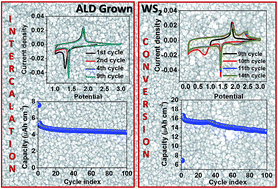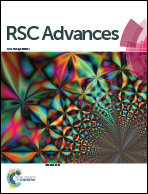Intercalation based tungsten disulfide (WS2) Li-ion battery anode grown by atomic layer deposition†
Abstract
Thin films of tungsten sulfide (WS2) are prepared by atomic layer deposition (ALD) and its intercalation properties as an anode material in Li-ion battery are studied. The self-saturation growth of the material and the temperature window for ALD growth is confirmed by in situ quartz crystal microbalance (QCM). In situ Fourier transform infrared spectroscopy (FTIR) and residual gas analyzer (RGA) studies help to predict the two half reactions and FTIR further validates the self-limiting feature of ALD growth. The as-grown WS2 is amorphous in nature and characterized in detail by XPS and Raman spectroscopic analysis. The as-grown films are tested as a suitable intercalation based material for Li-ion battery anode. CV measurements are carried out extensively to explore the dominant intercalation property of the WS2 anode. Stable cycling performance with high coulombic efficiency (>99%) up to 100 charge–discharge cycles is observed. To enhance the performance further, multi walled carbon nanotubes (MWCNTs) scaffold layer is introduced that helps to deposit more active material for the same number of ALD cycles.


 Please wait while we load your content...
Please wait while we load your content...